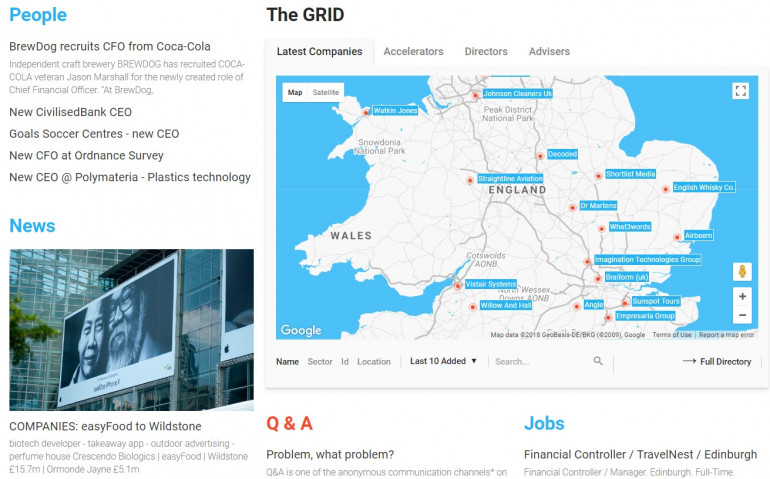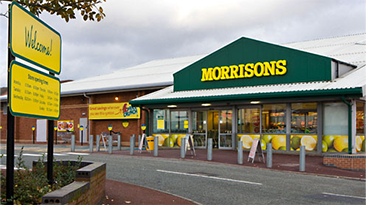Published by Directorzone Markets Ltd on November 1, 2016, 9:00 am in Knowledge, Market Info
Wednesday January 1st 2020
Digest of news and trends in the GRID marketplace in October 2016:
Password (Un)Protected | Low Pay Rises | Fashion Down, Leisure Up… | Business Rates Crisis | Older Entrepreneurs | Corporate Venturing Is Back, Bigly | Brewonomics
PASSWORD (UN)PROTECTED
Want to find the weakness in your system? Look in the mirror | Kathryn Parsons, co-founder and co-chief executive at Decoded, The Sunday Times. October 30
… the US Department of Homeland Security runs National Cyber Security Awareness Month every October, mirrored in the EU by CyberSecMonth.
Almost every chief executive knew their business was just as unprepared (as TalkTalk), and their customers’ data just as vulnerable to any hacker with basic coding skills. It was not a case of if they would be hacked, but when.
…the training sessions we run at my firm, Decoded. Executives from some of the world’s biggest companies …get to learn how to perform a “man in the middle” attack or an SQL injection — two common types of hack. They experiment with encryption technology and gain a general understanding of the dark arts of the world of cyber-security.
Mostly, they are keen to know who the hackers are — and how they can be stopped. …there is one protagonist who is almost always missed and is by far the most dangerous — the bored, lazy, unmotivated professional. The person with the password “password1234”. You.
You are the most dangerous thing to your organisation and to your government. A company could invest in the most sophisticated technology and technologists, but what is the point when, in security terms, you’ve left the doors wide open? It’s frightening that two-thirds of us haven’t changed passwords in the past five years. Almost a quarter haven’t changed in 10 years — not since before the first iPhone had been created.
What can you do? Use a password manager such as LastPass, True Key or Dashlane and create one unique, unhackable password. Or visit Hacksy, a chatbot designed to help you discover whether your password has been leaked and to change it to something unhackable within minutes — a system we launched in partnership with the White House this month.
There are ways to engage staff with the threat, such as war games where executives have to respond to mock cyber-security attacks; hacker leaderboards where teams compete to increase their security rank; and rewards for anyone internal or external who can find and flag up insecurities. …engagement is essential …The only thing worse than fearing hackers is being so afraid you do nothing.
LOW PAY RISES
UK’s low earners receive fastest pay rise in 20 years | Sarah O’Connor, FT. October 27
Living wage results in 6% increase in a year for poorest workers
Britain’s lowest-paid employees have received their biggest raise for nearly 20 years after the government forced companies to pay a new national living wage of £7.20 an hour to all workers aged over 25.
Official figures, which give a detailed annual snapshot of pay trends across the economy, show that low earners, part-timers, women and young people were the biggest winners over the past year.
It is the biggest government intervention in the labour market since the 1990s and has divided economists. Some think it will tackle income inequality and boost productivity, while others believe it will cost jobs.
In spite of the recent recovery in pay, average workers are still earning less in real terms than before the financial crisis hit. Economists believe real wages will start to fall again next year because declines in sterling since the Brexit vote are expected to trigger higher inflation.
The gender pay gap has continued to narrow, although the TUC trade union federation said progress had slowed to a “snail’s pace”. The difference between men’s and women’s full-time median hourly pay fell from 9.6 per cent in 2015 to 9.4 per cent in 2016. This is the lowest since the series began in 1997.
The gap between low-paid men and women fell more sharply to just below 5 per cent. This is probably a side effect of the national living wage — there tend to be more women than men at the bottom of the pay ladder. However, the gap for top-earning men and women remained stubbornly wide at about 20 per cent. It has barely changed since 1997.
While the government will be pleased that pay is rising fastest among the lowest paid and in regions outside London, officials are increasingly worried about a group of workers not covered by Wednesday’s data: the 15 per cent of the workforce that is self-employed. About 45 per cent of this group earns less than the national living wage and …officials and experts worry that some of them are becoming an insecure and badly paid underclass. Theresa May, prime minister, has ordered a review of workers’ rights in the so-called gig economy of independent workers, with a particular focus on companies such as Uber and Deliveroo.
FASHION DOWN, LEISURE UP…
Decline of high street clothes shops accelerates | Paul McClean, FT. October 25.
A report from PwC found that more than 2,600 UK high street shops closed in the first six months of 2016. The number of shops opening also fell, meaning that overall there were 503 fewer shops by June — the biggest loss since 2012.
Clothes outlets have declined the most. Banks, mobile phone stores and recruitment agencies also made the list of big fallers.
Retailers point to the lack of major trends in the past 10 years to encourage the fashion-conscious to update their wardrobes. Analysts add that millennials tend to save money for experiences such as holidays and eating out.
The volume of clothes bought in the UK fell for the first time in 20 years this year. Marks and Spencer, the largest retailer with 10 per cent of the market, is cutting jobs…
While fashion shops are struggling, leisure chains are doing well. Coffee shops, health clubs, takeaway food shops and foreign restaurants made a net 43 openings between them during the first half of the year.
Tobacconists, including ecigarette shops, registered the greatest number of net openings with 28, thanks to a boom in vape shops. UK ecigarette sales are expected to reach $1.7bn this year, according to Euromonitor — up 43 per cent year on year.
BUSINESS RATES CRISIS
Shopkeepers are raging over the revision of the business rate | Kiki Loizou, The Sunday Times. October 9
In the first review of the tax in seven years, companies in London and southeast England are expected to be hit with an increase in charges next April while businesses in the north of England are set enjoy a discount.
Business rates, which raise £28bn a year for councils and the government, are based on what it costs to rent a property — and, where the so-called rateable value of properties has increased, charges to businesses will too. Next year’s rates will be based on 2015’s rental values.
Lobby groups such as the Federation of Small Businesses continue to call for reform of the archaic rates system, which does not take into account how a company is performing. They have also asked that assessments be carried out far more frequently to avoid sharp rises for those who might struggle with the payment demands. So far, appeals have been ignored.
Londoners are expected to see a much steeper increase than outside the capital, with an estimated rise of 14% for retail businesses.
Alan Hawkins, chief executive of the British Independent Retailers Association …has seen many of his bricks and mortar members go under while struggling to pay their business rates. “We lose 7% of our members each year because they’ve gone out of business. Rates is probably the No 1 issue,” he said.
London retailer Vin Vara, founded his TOOL SHOP business in 1997, …his hardware chain with 11 London stores and a warehouse …has revenues of almost £3m. He employs 36 staff. He predicts his total rates bill could rise by £34,000 to more than £150,000.
Hipster hammering: City Fringe offices landed with huge business rate increases | Helen Cahill, City A.M. October 11.
Business rates that hit London need reform | Tracey Boles, City A.M. October 11.
The government has published its first business rate re-evaluation since 2010. Rates are due to rise from 1 April 2017 after a revaluation of rateable values for England’s 1.85m commercial properties by the Valuation Office Agency.
The new tax for each property is based on its rent, and as rents in the City Fringe have surged in recent years, these areas will be hit with some of the biggest increases. The worst-hit office hot spots include Farringdon, with an average 75 per cent increase, Shoreditch (54 per cent) and Clerkenwell (47 per cent).
The huge rises in business rates for City Fringe locations is due to their popularity with technology companies, which have been moving into these areas and driving up rents.
Business rates are … set to deliver a heavy blow to London’s retailers, offices and hotels. Rises for London attractions include 142 per cent for the O2 arena, 90 per cent for the Tower of London and 70 per cent for the London Eye; West End retailers Harrods, Hamleys, John Lewis and Selfridges are all facing increases over 50 per cent, while the Dorchester Hotel will see a 54 per cent rise.
The Bank of England is looking at a 61 per cent hike. The extra burden for London as a whole could be £885m a year according to the latest estimates from Gerald Eve.
The government has proposed more local power over rate-setting but this may create a confusing patchwork of measures and exacerbate the north-south divide. Instead, more frequent revaluations would better reflect changes in market rents and demand for space, and may give retailers some much needed relief from the very large financial headache of a punitive rate rise once every five years. The financial dynamism of the West End post-Brexit rests on it.
OLDER ENTREPRENEURS
Older entrepreneurs pass ‘pint of beer’ test with investors | Jane Bird, FT. October 6.
…entrepreneurship among older people is rising. … particularly so in less developed economies where there are fewer jobs, says Donna Kelley, professor of entrepreneurship at Babson College, Massachusetts. The 2015 Global Entrepreneurship Monitor survey, which she co-authored, found that in less-developed countries, 17 per cent of founders were aged 55-64, the same ratio as among 18-24-year-olds. A further 21 per cent were 45-54.
Start-up founders are often older, says Prof Young, because it takes time to gain knowledge in areas such as computer science, mechanical engineering and robotics. However, older digital entrepreneurs need fairly young and energetic partners to help bring projects to completion.
Despite this, age can be an obstacle to raising cash, says Peter Cowley, a business angel in the UK. Entrepreneurs need to be there long enough for an exit to occur and must have energy, agility and drive. But …even those who have not run a business have been in the workplace a long time and better understand resources implications such as recruitment.
Older people can also build on past mistakes ….California-based investor Ronjon Nag, who has backed many digital companies in the US and Europe: “Older entrepreneurs are likely to have made more mistakes and are less likely to repeat them.” The average age of founders he has backed is over 38, and several are well into their 50s. The older ones tend to have more connections, he says.
One problem for older entrepreneurs is how long they might want to keep working after the business is sold.
Older entrepreneurs have the advantage of being closer in age to most investors. This helps them pass the “pint of beer” test, says Mr Cowley, where the investor takes the entrepreneur for a drink to find out whether the relationship will work at a personal level.
Given demographic trends towards longevity, Mr Nag says older digital entrepreneurs may have more insights into future trends. “They will be better placed to create products for the fast expanding ageing population.”
Start-up tips for the not-so-young:
- Have a younger co-founder to show your business has the required energy.
- Be prepared to continue working if your business is acquired.
- Have a succession plan if you are likely to take more than 10 years to achieve an exit from your business.
- Target areas where older people may have knowledge, such as health systems.
- Choose a field where your wide network can help, either as employees, investors or customers.
- Put in your own money, even if it is only a small amount.
- Be open about your mistakes with others and learn from them.
- Recruit slowly — but fire fast if you need to.
Technology entrepreneur Steve Young launched his most recent appeal for venture funds at the age of 63. The part-time professor of information engineering at Cambridge university wanted backing for VocalIQ, a speech-related artificial intelligence company he founded with a then 31-year-old member of his Cambridge research group. The pair raised £750,000 in June 2014 and delivered a rapid return on their backers’ investment in October 2015, when the company was sold to Apple.
CORPORATE VENTURING IS BACK, BIGLY
Corporate venturing: entrepreneurs enter the embrace of bigger companies | Brian Groom, FT. October 4
Large corporations are increasingly seeking relationships with start-ups, driven by the need for innovation and the fear that a nimble upstart will turn their business model upside down. They are collaborating with start-ups in various ways, from competitions and hackathons to setting up venture capital arms and corporate accelerators.
Yet corporate venturing, where big businesses invest in start-ups, has a mixed reputation and has been through several ups and downs. At the end of dotcom boom, many companies shut or spun off their incubators and investment teams.
Now it is undergoing a boom. Companies worldwide made $75.4bn worth of corporate venture investments in 2015, five times the level of 2012, according to Global Corporate Venturing, which monitors the industry. About a third of European accelerators are run or supported by big businesses.
Start-up accelerator programmes are usually associated with technology companies, but they have spread to a wider range of organisations, such as Barclays, retailers Topshop and Asos, and betting group William Hill. Accelerators provide office space, training, mentoring and sometimes investment, usually up to £200,000.
There are pitfalls for the unwary, however. Corporate investors who demand preferential rights, such as first refusal on a deal or clauses that ban start-ups from working with competitors, can put off other investors and customers. London in particular has nearly 50 accelerators of various types, leading to accusations that some offer poor value in return for a stake in a small business.
- Ben Branson created SEEDLIP, which makes non-alcoholic distilled drinks, less than a year ago but already Distill Ventures, set up by Diageo, the world’s largest distiller, has taken a minority stake. Distill Ventures allows Diageo to make small bets on emerging brands at a time of changing consumer tastes that include drinking less alcohol. “Something crazy like nine out of 10 food and drinks start-ups fail within or just after their first year,” says Mr Branson who recently completed Distill’s accelerator programme. The investment from a company that knows the industry will be a big benefit, he says. Distill Ventures’ model gives it an option to buy the company outright at a future date. That would not suit every entrepreneur, but Mr Branson is happy with the arrangement because “I don’t want Seedlip to be small and I don’t want to do it for the rest of my life”.
- David Levine, founder of DIGITALBRIDGE, a Manchester-based start-up whose technology enables users to upload a photo of a room in their house and customise the wallpaper, paint and furniture, has just completed retailer John Lewis’s JLAB accelerator programme. Having worked for big, ponderous companies, he was “sceptical to say the least”, but was then delighted with the scheme’s bespoke advice and mentoring. An in-store trial, in which John Lewis customers could see what products would look like in their home, was set up within five days.
- VIDSY, whose self-service platform enables brands to commission and distribute video content from 1,500 film-makers, is involved in Founders’ Factory, a London accelerator backed by companies such as Aviva, L’Oréal, Guardian Media Group and Holtzbrinck Publishing. Gerard Keeley, Vidsy’s chief executive, says the credibility this confers “was a very important thing for us, given that we are selling directly to the top 250 advertisers”.
- UK-based start-up, APPYPARKING, a smartphone app that helps drivers find parking spaces. Aviva Ventures, the insurer’s recently created venture capital fund, invested $1.5m seed funding in January. AppyParking had previously won a $10,000 prize from Ford in a competition to find ways to relieve congestion and now supplies data to the carmaker. It has also taken part in Microsoft Ventures’ accelerator programme, which was “like a mini-MBA”, says founder Dan Hubert.
- TIO, developer of an app that enables children to build moving toys and robots, won a £10,000 Varsity Pitch competition funded by Tata, the Indian-owned group, and now takes part in events with Tata Consultancy Services. Tio is “an educational toy with a mission to increase Stem [science, technology, engineering and maths] skills,” says Peter Spence, Tio’s co-founder. “It’s important that things are aligned on not just the competitive or financial side, but on your social goals.” Tata is a good fit because of its focus on engineering and tech, he says.
Before becoming involved with corporate venturing, entrepreneurs should ask if their goals are aligned with those of the larger business.
For big companies, questions remain over the value they derive from their activities. Many are still working out how to evaluate the impact of accelerators, but they seem likely to do still more of it. Stuart Marks, chairman of innovation specialist L Marks, which has assisted John Lewis and others in setting up accelerator programmes, says: “So many corporates are being bombarded by disruptive forces that this is the only way they can continue to stay ahead of their game.”
Tearing down the walls that can block creativity | Simon Duke, The Sunday Times. October 30.
The trend towards a less structured working life has been gaining momentum. In January, the insurance giant Aviva opened a “digital garage” in Hoxton Square, at the centre of London’s tech scene, to develop new products and harness advanced data analytics to boost profits. Like EY, Aviva is also renting in co-working spaces, such as Second Home.
Rohan Silva, Second Home co-founder, sees his venture as a bridge between big business and start-ups — a place where they can both feed off each others’ strengths. Established companies are being forced to “turn themselves inside out” and embrace new models of “open innovation” and collaboration…
Second Home offers other amenities to help spur creativity, including regular evening talks from the likes of Sir Richard Branson and the fashion designer Stella McCartney. Large businesses hope to glean something more ineffable; through collaboration they hope to kindle a creative spark.
BREWONOMICS
Brewery opens every 3 days in thirsty Britain | Scheherazade Daneshkhu, FT. October 3
A new brewery opened every three days in the UK last year as entrepreneurs sought to capitalise on the thirst for craft beers with outlandish names such as Northern Monk Lust and Mad Hatter Wee Buns. The 134 new breweries took the UK total to 1,692 last year, up 8 per cent on 2014, driven by microbreweries producing craft beer.
Demand for locally produced or interesting new beers, which typically have stronger flavours than mass-produced mainstream beers, has been the main reason for the 65 per cent rise in breweries in the last five years, from 1,026 in 2010.
- Successful microbreweries have been in demand from large, established producers keen to increase their presence in the industry’s main area of growth. Last year, Anheuser-Busch InBev, the Belgian brewer of Stella Artois and Budweiser, bought the Camden Town Brewery just five years after it opened.
- Similarly, SABMiller bought London’s Meantime Brewery last year, before itself being taken over by AB InBev in a £79bn deal due to complete next week, when Meantime will be sold on to Japan’s Asahi.
UHY Hacker Young said the investment from larger brewers gave microbreweries potential access to funds for international expansion or to produce a more extended portfolio of beers. The accounting group also said the weakness of the pound since June’s referendum vote to leave the EU was likely to benefit craft brewers more than the mainstream brewers.
Though craft beer has injected momentum into an otherwise sluggish sector, beer has continued to lose out in popularity to other types of drink, especially wine. Spending per head on alcohol in the UK increased 41 per cent between 2000-2015. The amount spent on beer rose just 4.1 per cent compared with 68 per cent on wine and cider, according to the British Beer and Pub Association, the industry group.








